
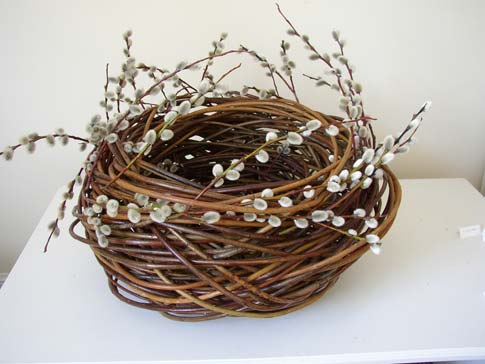
BASKETS OF DELIVERANCE
Following her instinct and allowing the organic materials themselves suggest shapes, circularity and the human life cycle are themes oft repeated in Lizzie Farey's much-collected work.
Profile by Charlotte Wood .
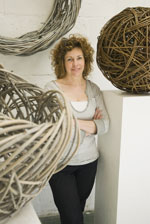
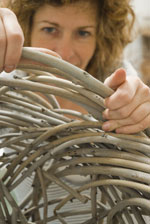
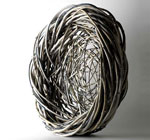
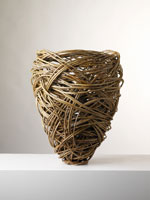
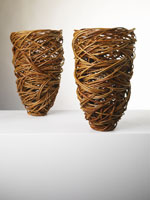
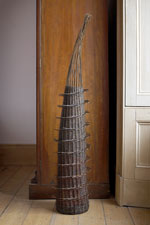

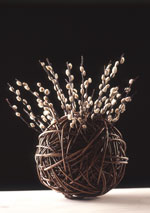
IT is difficult to find a deeper expression of the way UK willow artist Lizzie Farey's work connects people to the profound forces of nature than a phone call she received recently. It was from a bereaved father, asking if Farey would weave a willow coffin for his baby.
'I came back from the workshop one evening to a message on my answer phone from a designer in Berlin. He had tried many different routes to contact me and was sure that I was the right person to make the coffin, which he wanted in the style he described as raw, free and wild,' she says.
Unlike almost all her other commissions, there was little time for Farey to ponder this work; the funeral would be in Germany, less than a week away. She said yes.
'I had some willow already soaking to make sculptures for a forthcoming open studio event. Once I'd agreed, the father sent a photo of the baby to me by email, and I couldn't help but feel involved. There was something very profound going on that I didn't quite realise at the time, but I knew I had to do it.'
For Farey - whose woven willow artworks have been described as "fluid", "sculptural" and "cunningly beautiful", and have shape-shifted through the years from traditional basketry to public works, living willow walls and more recently, purely abstract indoor sculptures - this was certainly one of the most challenging tasks of her career, both emotionally and technically.
She set about making the piece and worked for three days non-stop. The coffin was over a metre in length and the weave had to be quite dense to comply with the funeral director's requirements. 'I worked hard and put as much love, peace and calm into the process as I could. A friend came and played her flute when she heard what I was doing,' says Farey.
The request may have been unusual, but the depth of emotional response from clients to her work is no longer surprising. 'When I'm working on a piece I'm quite self-conscious. Sometimes I'm using the work to resolve personal issues; maybe to do with being a twin, or rela-tionship stuff. This, in turn, often seems to create an emotional response in other people,' she says.
When Farey first took her work to London's prestigious Chelsea Craft Fair in 2004, where artists meet and talk face-to-face with the public, a woman came and stood before Eulogium, a piece Farey had made just prior to the show, after her father had died in a tragic accident. 'She burst into tears when she saw it. It turned out her twin sister was dying of cancer. She bought the piece and I got the impression that it meant a great deal to her. Rachel my sister and I were standing there, trying des-perately not to flood the room with our own tears when she told her story.'
Farey sometimes makes several, though by their nature each unique, versions of the same piece - and Eulogium had the same effect on another woman who visited her studio some time later. Is this effect a conscious one?
'When I'm working I'm not striving for the piece to be beautiful anymore,' Farey says. 'I think I used to want the work to be liked, but this has changed. Now the work aims to express a part of me; and as long as I'm satisfied that it's done that, then it's finished. It isn't an easy process, though. Almost every piece of work has to go through a kind of chaos or madness - it can literally all fall apart; I call it a pain barrier - for me then to bring it back to something calmer, happier and complete. But when a client installs the piece in his or her home, what I hope for is that calmness to communicate itself to the viewer or owner.'
Circularity and the life cycle is a theme that seems to arise repeatedly in Farey's much-collected work. Even the bereaved Berliner's poignant commission has echoes back to the very beginning of Farey's career: her inter-est in basketmaking was piqued when, while visiting her brother and his wife in Wales at the age of 27, she watched her sister-in-law weaving a baby's cradle.
At that time a stained-glass maker, Farey was instantly drawn to the flexibility, the beauty and purely natural origins of the materials. This attraction seems inevitable when you consider her countryside upbringing.
Born in Singapore in 1962, Farey and her twin Rachel were the youngest of five children of a naval submarine commander. He and Farey's mother, she says, 'knew how to run a happy ship', providing a smooth and stable childhood for their family, who returned to live in England's Cotswolds district when she was still a young girl. An idyllic, nature-loving childhood sowed the seeds for Farey's later artistic expression.
'Dad took us on holidays to Scotland to a place called Carradale on the Mull of Kintyre. It was there, aged about seven, that I first experienced my deep love of nature. I would go off on little adventures on my own and find a secret wooded glen and just sit there,' recalls Farey. And it was in this environment where her deep love for Scotland, where she has lived since 1987, developed. Scotland, she says, is 'the sort of a place that is in your soul, that will remain with you forever'.
A dissatisfied school student, Farey found college too restrictive as well, abandoning a fine arts degree to travel through Europe before eventually returning to the UK to learn the trade of picture framing, and then stained-glass making.
She was totally committed to exploring the aesthetic possibilities of contemporary stained-glass and set up a business working out of the stable studios at Drumlanrig Castle in Dumfriesshire. Her commissions included church repairs and contemporary public works. Then one day came the Lockerbie plane disaster.
'I was asked to do the memorial windows for that. But after extensive research and many stories of that dread-ful night in Dumfriesshire, I realised that it was a task too painful for me to endure.'
During this period a visit to her basketmaking sister-in-law proved fateful and changed the course of her life. Farey was amazed to discover that she could make a simple willow basket in an afternoon, whereas to make a stained-glass window would take weeks'.
She quickly learned the basic techniques and how long to soak willow before it was pliable enough to use, and the necessary mellowing process, and bought two bolts of willow from Somerset and started. 'I packed up the stained-glass business and moved to an isolated cottage in the hills, where I lived for the next four years, all the while learning and improving my skills as a basketmaker' Having mastered traditional techniques, it was around this time that Farey began breaking away from them.
'I started using the materials that grew around me, not just conventional willow bought in from Somerset, which was what most basketmakers were doing. I planted a field of my own willow and had lots of wonderful differ-ent colours and varieties. I used the larch which sur-rounded my cottage, the field rushes, bog myrtle, birch catkins, heather, hazel, ash, rowan and wild plum.'
In 1997 Farey quit her part-time job and began to focus professionally on basketmaking. Using materials other than willow wasn't new - "hedgerow basketry" was an established practice - but finding traditional weaving patterns restrictive, she soon developed her own unique style of random weaving, following her instinct and letting the materials themselves suggest shapes which became non-functional, sculptural pieces.
The British Crafts Council magazine CRAFTS featured one of her willow and catkin spheres on its front cover in November that year. Overnight, all Britain's major crafts galleries and several in Europe knew Farey's work and name, and offers of commissions, exhibitions, pub-lic art, installations and collaborative projects poured in. And it hasn't stopped. Her work has since been exhib-ited by BrownGrotta Arts in the US, Sotheby's in New York and London, and the Victoria & Albert Museum, among other major British and European institutions.
But success hasn't always sat easily with Farey, especially in the very early days.
'Sometimes it had a detrimental effect. In 1997 I had only just started out, and lacked the confidence and experience that only comes with time. I basically stum-bled from one request to another, sometimes having to backtrack completely with promises over work, having taken on too much.'
These years also saw some extremely difficult periods of anxiety and tension which, ultimately, both fuelled and hampered her creativity, sometimes causing her in withdraw completely from all studio work - but also allowing space for the vulnerable emotional undercurrent of her work to which viewers respond so strongly.
Since 2002 Farey has had a workshop at Lochdougan Farm in Dumfries and Galloway, a few miles up a country road from the tiny village where she lives. While her technique and forms have changed signifi-cantly since she began, there is one constant influence in her work: the landscape in which she lives, which in turn yields the materials themselves.
'The landscape around here is quite beautiful. It's not overly dramatic like the Highlands but it has these hills and lochs which have a gentle effect. I'm sure it has had a profound effect upon me. The other main thing about this area is the sense of community. Although I work alone, there are friends all around me, and the village is amazing. When the postman dropped off some plum prunings at my door the other day it was the most normal thing in the world.'
After 15 years of growing willow and experimenting with all the different woods, she feels that the emotional core of her work stems partly from her deep sense of ease with her materials. The common names of her wil-lows read like the colours of a rainbow, and colour is the reason she chooses to grows so many varieties. A brochure accompanying her work includes a list of the willow varieties - 'a bit like a poem':
Flanders Red, Brittany Blue,
Oxford Violet, Black Maul,
Black Satin, Purple Osier,
Green Dicks, Dicky Meadows,
Whissender, Newkind and Maudesley.
Farey has recently begun using coppiced ash, which is bigger and smoother than willow but much more diffi-cult to work. 'I acquire it from the hedgerows. It easily snaps if pushed too far, but it has this robustness about it and I get a real flow when I make the big rings out of it - it's nature communicating.'
A major turning point, which was both personal and artistic, came in 2003 with her father's sudden death.
'My work became even more personal. For the first time, I consciously used the emotional pain to create works of art such as Eulogium, a eulogy in willow to my father, and Three Sisters, a piece about the week leading up to his funeral when my two sisters and I worked together in a way - it was unforgettable - like a kind of dance.'
Farey now focuses on creating abstract works for the interior, turning down most requests for living willow sculptures and other outdoor works. Her latest work looks to Asia in its influence - particularly Japan.
'My recent trip to Japan was a turning point for me and I will work on deepening this relationship. I decided to go there again this Easter to take a friend's ashes to be blessed in a 500-year-old monastery. My friend was an environmental artist and we had shown our work together in New York and Sotheby's. I wanted to visit Japan, where she had worked and had good friends. I accompanied her daughter. I was particularly moved by the Zen rock gardens in Kyoto. I took off for five days on my own up to the mountains in Fukui and visited the free school related to the one near here. I think it will be an ongoing thing for me. I'm doing a course in Japanese woodblock printing in a couple of weeks, and have also completed a course in traditional bamboo basketry, with a Japanese Master.'
So once again, the cycle of life - born of nature itself - takes thematic and physical hold.
'I hope that by making something out of a material that took a year to grow, was cut by my own hand, then dried, sorted, soaked for a week, mellowed and selected by me for its individual effect, gives the work a kind of value that is different. But who knows? Perhaps it does not matter. But being committed to the cycle of the seasons in this way means I'm literally rooted to this life.'